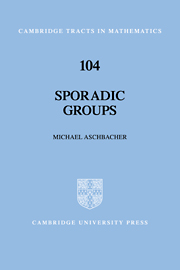5 - The Discovery, Existence, and Uniqueness of the Sporadics
Published online by Cambridge University Press: 04 August 2010
Summary
In this chapter we discuss the history of how the sporadic groups were discovered and were first shown to exist uniquely. Then we provide a general outline of how Sporadic Groups proves the existence of the twenty sporadics which are realized as sections of the largest sporadic group, the Monster. Finally we outline our approach for proving the uniqueness of the sporadics.
Chapter 5 includes several tables. At the end of Section 15 is a table listing the twenty-six sporadic groups with the notation and name used in Sporadic Groups to label the group. This table also lists the group order. The table at the end of Section 16 summarizes the existence results proved in Sporadic Groups.
History and discovery
Group theory had its beginnings in the early nineteenth century, with Galois making some of the most important early contributions. For example, it was Galois who first defined the notion of a simple group in 1832. During most of the nineteenth century the term “group” meant “permutation group.” Thus it is natural that the first sporadic groups were discovered by Mathieu as multiply transitive permutation groups; papers describing this work appeared in 1860 and 1861 [Ml] [M2].
More than a century passed before the discovery of the next sporadic group. This is perhaps not too surprising, since with a few notable exceptions in the work of mathematicians such as Burnside, Frobenius, Brauer, and Phillip Hall, there was little progress in the theory of finite groups during the first half of the twentieth century. However, in the mid fifties three crucial events occurred in finite group theory.
- Type
- Chapter
- Information
- Sporadic Groups , pp. 65 - 76Publisher: Cambridge University PressPrint publication year: 1994

